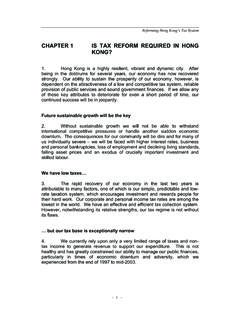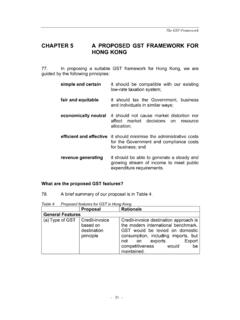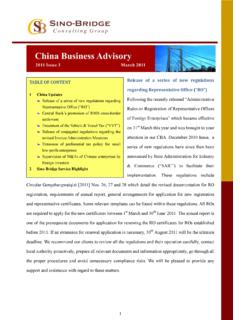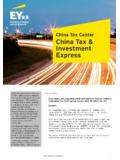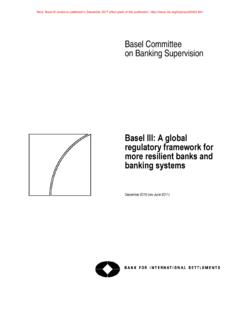Transcription of SME Tax Compliance and Simplification - OECD.org
1 1 SME Tax Compliance and Simplification Background note prepared by the OECD Centre for Tax Policy and Administration for a Roundtable Discussion at the 1st Meeting of the Working Group on Taxation of the SEE Investment Committee _____ This note considers tax Compliance costs imposed on small and medium-size enterprises (SMEs) with regard to their possible effects on the competitive position of firms and firm behaviour, and steps taken by a number of OECD countries to lower these In particular, the note considers how tax Compliance cost considerations may factor centrally into a number of decisions, for example, whether to become self-employed,2 and whether to operate in the formal economy.
2 Information applicable as of January 2007, is provided and discussed, gathered from a questionnaire to OECD countries on provisions of value added tax (VAT) and income tax systems targeted at small businesses to simplify their Compliance requirements ( permitting simplified accounts, simplified tax calculations, less frequent filing) and thereby lower their tax Compliance costs that is, lower the amount of time and resources required by firms to comply with the tax system (aside from their tax liability). Depending on design features, Simplification measures may not only lower tax Compliance costs; certain measures may also provide small businesses with the additional cost savings of reduced tax payments to With or without this additional cost savings, reduced tax Compliance costs encourage increased SME creation and Compliance with a tax 1 The total resource cost to business of a given tax system may be considered as consisting of two parts the amount of money that taxpayers are required to pay to government, to meet their tax liabilities (which may be loosely referred to as the statutory tax burden )
3 , and the amount of administrative resources not paid to government but required to determine, document and make tax payments so-called tax Compliance costs (including recording transactions, maintaining accounts, computing and filing tax returns, etc). Measures that reduce tax Compliance costs ( less frequent filing and payments of a given amount of tax liability) may involve reduced payments to government. Likewise, measures that adjust the statutory tax burden, or the way the tax burden is computed, may result in decreased (or increased) tax Compliance costs. A further consideration is an analysis of the economic incidence of these costs that is, an examination of how the burden of this total resource cost is reflected in higher consumer prices, reduced total returns to labour and reduced total returns to capital.
4 2 This recognizes that for many employees, personal income tax and social security contribution calculations are carried out by employers (with tax withheld at source), saving employees considerable time/cost associated with self-assessment, record keeping and tax payment. For other employees, where tax is not withheld and Compliance costs are met individually, the time/cost in completing and submitting tax returns may be relatively low for an employee, compared Compliance costs facing a self-employed individual, or the owner/worker of an incorporated company, which may grow as the complexity of the business operation expands 3 In principle, possible effects of Simplification measures on the amount of tax paid to government should be assessed on a present value basis.
5 This approach would take into account savings from less frequent filing requirements which do not affect the total amount of tax paid, but the present value of the payments, owing to the time value of money. 4 Compliance costs may also affect business growth where they vary with firm size, for example where they adjust sharply when turnover or some other size-related threshold is crossed that influences tax burden. A particular example arises when moving from a simple presumptive system to a regular income tax. Recognizing this, policy makers generally aim for a relatively smooth transition in tax burden between regimes. After considering first in section A the rationale for taxing small businesses under a simplified set of rules and procedures, various provisions to simplify Compliance with a VAT are reviewed in section B, with a focus on measures reported by the survey countries.
6 Section C discusses provisions to simplify Compliance with income tax, while section D examines reported Simplification measures in relation to social security systems (contributions by small businesses as employers and by the self-employed) and in other areas where small businesses play a withholding function. The country examples do not address provisions that may be applied by tax authorities in certain cases to assess and impose tax liability where a taxpayer is unable or otherwise fails to comply with the regular tax system (including cases of apparent tax evasion and avoidance). A. Rationale for Simplification Compliance costs tend to increase with the number of taxes that an entrepreneur is subject to, the complexity of the tax rules, the frequency of submitting tax returns, and the number of levels of government involved in levying and collecting tax.
7 For example, in most countries, businesses must contend with a VAT system (unless the business falls under a VAT exemption threshold) not faced by an employee. Business income tax also introduces complexities not relevant to an employee that pays tax only on labour income and non-business investment income. Complexities may multiply where more than one level of government is involved in levying and/or administering a tax and rules and procedures are not well co-ordinated. Given differences across countries in the number and types of taxes on business, the complexity of the rules, and the levels of government involved, it is not surprising that Compliance burden assessment is very much country specific and difficult to compare.
8 Compliance costs are difficult to measure (making difficult a comparison of the total tax burden), but certain comprehensive studies may be found. Recent studies of business Compliance costs in the include Blumenthal and Slemrod (1992), Hall (1995), Slemrod (1996), and Slemrod and Venkatesh (2002). Studies by Ariff, Loh and Talib (1994), Ariff, Loh and Ismail (1997) and Chan, Cheung and Ariff (1999) consider business Compliance costs in Hong Kong, Malaysia and Singapore. Pope (1995) and Sandford and Hasseldine (1992) study business Compliance costs in Australia and New Zealand. As a broad finding, such studies systematically conclude that while total business tax Compliance costs tend to be higher for large companies, as a percentage of sales they are significantly higher for SMEs.
9 Another interesting finding is that tax-planning accounts for a larger proportion of total Compliance cost for large firms. While the Compliance tax burden facing an SME is case specific and thus difficult to measure, a broad conclusion to be drawn is that the burden is high relative to large companies and relative to the tax Compliance burden for payroll employees. This suggests that if the statutory tax burden on a given amount of labour and capital income is roughly the same for an employee as for a self-employed individual, then the higher Compliance burden for the latter would mean that the tax system is non-neutral, tending to discourage SME creation.
10 By reducing tax Compliance costs and thereby lowering the overall tax burden on small businesses, Simplification provisions help achieve more neutral tax treatment of firms of varying sizes, implying efficiency gains, and encourage Compliance with (adherence to) the tax laws of a country, including operating in the formal rather than informal (underground) economy,5 and full reporting of all amounts required to determine the true tax 5 Difficulties are met in gauging the extent to which Simplification translates into increased Compliance with (adherence to) a tax system ( increased participation in the formal economy, less underreporting of taxable income by those that file).










